|
The Greenhouse Delusion - Chapter 1, by Dr Vincent GrayThe History of the Greenhouse Effect
Jean Baptiste Joseph, Baron de Fourier (1) , as early as 1807, suggested that the earth’s atmosphere acts like the glass of a hothouse because it lets through the light rays of the sun but retains the dark rays from the ground. The suggestion is included in his Theorie Analytique de la Chaleur (2) John Tyndall in 1858 (3) carried out the first reliable experiments on the infra red properties of water vapour and carbon dioxide, resulting in his estimate that water vapour is the key greenhouse gas. The first extended scientific paper on the greenhouse effect was by Svante Arrhenius (4) in April 1896. Arrhenius was to receive the Nobel Prize for Chemistry in 1903 for his discovery of ionic dissociation. Arrhenius assumed that water vapour and carbon dioxide in the air are transparent to the sun’s rays, but absorb part of the infra red emissions from the earth. He calculated the effect by subtracting the infra red spectrum of the moon, which would undergo absorption, from that of the earth. He then calculated the effect of changing the atmospheric concentration of carbon dioxide. He found that a reduction of one third gave a temperature reduction of just over 3°C. Doubling carbon dioxide gave an increase of 5-6°C Although these results resemble some more recent calculations, the resemblance is fortuitous, as Arrhenius only considered part of the infra red spectrum, and the measurements were crude. His work was ignored for a number of reasons. The averaged results from weather stations in the Northern Hemisphere (Figure 1 ) showed a fall in temperature for the next 15 years. After that the world was preoccupied with two world wars and an economic crisis. There were no reliable measurements of concentrations of atmospheric gases thought to be responsible for the greenhouse effect; particularly water vapour and carbon dioxide. This book will show that there are still no reliable measurements of the chief greenhouse gas, water vapour, and that carbon dioxide is not as well characterised as is generally believed. The work of these pioneers is discussed by Fleming (5) and Baliunas & Soon (6) In the 1970s a number of scientists put out warnings that a new ice age was imminent. They were based on the supposed mean global temperature as indicated by an averaged record of Northern Hemisphere weather station measurements which showed a decline for 36 years (Figure 1. From Stanley (7)) This record convinced many scientists and journalists that a new ice age was about to commence. The US National Science Board 1972 stated: "Judging from the record of the past interglacial ages, the present time of high temperatures should be drawing to an end… leading into the next glacial age" (quoted in Matthews (8)) Rasool and Schneider (9) even argued that greenhouse warming would be overwhelmed by cooling due to aerosols, which "is believed to be sufficient to trigger an ice age." However, the combined weather station record began to reverse, so a warming crisis was now in order. On June 23rd 1988 Dr James Hansen, of the Goddard Institute of Space Studies in New York, told the US Senate that he had devised an improved method for calculating the average surface temperature of the earth from the many thousands of temperature measurements collected by weather stations (10) At about the same time Charles Keeling of the Scripps Institute of Oceanography, University of California, La Jolla, California, provided the first reasonably reliable sequence of measurements of atmospheric carbon dioxide concentration from 1958 (11), first from La Jolla, to May 1974, and then from the top of the volcano at Mauna Loa, Hawaii It showed that the concentration was increasing. There were developments in the use of computers to model complex systems. An early effort was by Forrester (12) in association with the Club of Rome publication The Limits to Growth. (13). Parameters such a population, quality of life, pollution, capital investment and natural resources were parameterized to show that some disastrous future consequences were likely in the near future if current trends continue. The disasters failed to eventuate, however. Another disaster exercise was the attempt to determine the climatic effects of nuclear war (14) It concluded that there could be a global "nuclear winter" which could destroy all human and animal life. Subsequent retraction of this conclusion was little publicised, so many still accept the possibility. Fortunately it has not yet been put to the test.
Computer climate models based on the theory that all climate change is caused by increases in greenhouse gases then began to appear (15). They seemed to show that the earth was soon to become uncomfortably warm. The following diagram (Figure 1.2) shows what was believed to happen (20). The extra greenhouse gases absorbed additional infra red radiation from the earth, part of which was re-radiated downwards to cause a heating effect. Because of the public concern, the World Meteorological Organisation and the United Nations Environmental Programme jointly established the Intergovernmental Panel on Climate Change (The IPCC) in 1988. It was set up In order to - Assess available scientific information on climate change, - Assess the environmental and socio-economic impacts of climate change - Formulate response strategies The second and third objectives depend heavily on the conclusions from the first, which, this book will argue, have been wrongly drawn. Working Group 1, which is responsible for the scientific assessment, has produced three major Reports (16, 17, 18) which will provide the main material for this volume.
The Reports consist of reviews of scientific work on the climate, divided into Chapters. The 1990 Report (16) and the 1995 Reports had several lead authors for each Chapter, plus a number of contributors. The 1990 Report also had an Executive Summary. The Second Report (17) had a Policymakers Summary, as well as a Technical Summary. The 2001 Scientific Report (18) had, for each Chapter, Coordinating Lead Authors, Lead Authors, Contributing Authors (and sometimes Key Contributing Authors) and Review Editors. There was an Executive Summary for each Chapter. Then there was a Policymakers Summary and a Technical Summary for the whole Report. There were three drafts of each Report, which were circulated to "Expert Reviewers" throughout the world for comment. This was probably the most extensive scientific exercise ever attempted. The third Report had 15 Review Editors, 124 authors and 397 expert reviewers The Reports form a valuable compendium of recent work on climate science, but as there is no index to any volume, individual items are often difficult to find. They are often spoiled by unjustified deductions and comments. Comments that were not welcomed by the main authors stood little chance of being considered seriously. The first report has it as follows. "Whilst every attempt was made by the Lead Authors to incorporate their comments, in some cases these formed a minority opinion which could not be reconciled with the larger consensus" The First Report (16) served as the basis for negotiating the United Nations Framework Convention for Climate Change. Climate Change 01 had two further Reports. The one from Working Group II was called Climate Change 2001 : Impacts, Adaptation and Vulnerability (19), henceforth referred to in this book as Climate Change 01 : Impacts The one from Working Group III was called Climate Change 2001 : Mitigation (20), henceforth referred to as Climate Change 01 : Mitigation In addition to the three major IPCC Scientific Reports there was a 1992 Supplementary Report (21), henceforth referred to as Climate Change 92, and "Climate Change 1994; Radiative Forcing of Climate Change and An Evaluation of the IPCC IS92 Emissions Scenarios" henceforth referred to as Climate Change 94 (22) References 1) Fourier, J B J. 1822 Théorie Analytique de Chaleur (Paris). Translated in 1878 by Alexander Freeman The Analytical Theory of Heat. Cambridge University Press. 2). Fourier, J.B J 1827. Memoires de l"Academie. Royale. de Sciience. de l’Institut de France tome vii. 3). Tyndall, J 1865 Heat a Mode of Motion 2nd Edn, p 405, London. 4). Arrhenius, S 1896. On the Influence of Carbonic Acid in the Air upon the Temperature of the Ground. Philosophical Magazine Ser 5, Vol 41, No 251, April 237-276. 5). Fleming, J. R 1998 Historical Perspectives on Climate Change Oxford University Press 6). Baliunas, S & Soon, W, 1999. Pioneers in the Greenhouse Effect. World Climate Report 4, (19); http://www.greeningeearthsocietyorg/climate 7). Stanley S M , 1989 Earth and Life through Time page 574, after J.M. Mitchell, in Energy and Climate; National Academy of Sciences, Washington. W.H. Freeman &Co New York, 8). Matthews, S.W. 1976 (November) What’s Happening to our Climate? National Geographic 576-6159). Rasool, S I & Schneider S H , 1971 Atmospheric Carbon Dioxide and Aerosols: Effects of Large Increases on Global Climate 10). Hansen J & S Lebedeff 1987 Global Trends of measured surface air temperature. J Geophysical Research 92 13345-1337211). Keeling C D, R D Bacastow, A F Carter, S C Piper, T P Whorf, M Heimann, W G Mook & H Roeloffzen 1989 Analysis of observational data. in Aspects of climate variability in the Pacific and the Western Americas (D H Peterson (Ed)) Geophysical Monograph 55American Geophysical Union, Washington DC USA 12). Forrester, J W, 1971 World Dynamics Wright Allen Press, Cambridge, Mass USA. 13). Meadows, D & M, 1972 The Limits to Growth.. Universe Books New York, also Pan Books, London. 14). Turco, R P, Toon, O B, Ackermann, T P, pollack, J B & Sagan, C. 1984 The Climatic Effects of Nuclear War. Scientific American 251 (August) 23-41 15). Schlesinger M F , & J F B Mitchell 1987. Climate Model simulations of the equilibrium climatic response to increased carbon dioxide. Reviews of Geophysics 25 760-798. 16). Houghton, J T , Jenkins G J , & Ephraums J J (Eds) 1990. Climate Change : The IPCC Scientific Assessment. Cambridge University Press. Henceforth referred to as Climate Change 90 17). Houghton, J T , L G Meira Filho, B A Callander, N Harris, A Kattenberg & K Maskell. 1996.. Climate Change 1995 : The Science of Climate Change. Cambridge University Press Henceforth referred to as Climate Change 95 18). Houghton J T , Y Ding, D J Griggs, M Noguer, P J Van der Linden, X Dai, K Maskell, C A Johnson (Eds). 2001. Climate Change 2001: The Scientific Basis Cambridge University Press. Henceforth referred to as Climate Change01 19). McCarthy, J J , O F Canziani, N A Leary, D J Dokken and K S White, 2001, Climate Change 2001" Impacts, Adaptation and Vulnerability. Cambridge University Press 20). Metz, B, O Davidson, R Swart and J Pan, 2001, Climate Change 2001" Mitigation Cambridge University Press. 21). Houghton, J T , B A Callander & S K Varney (Eds) 1992 Climate Change 1992 : The Supplementary Report to the IPCC Scientific Assessment. Cambridge University Press 22). Houghton, J T , L G Meira Filho, J Bruce, H Lee, B A Callander, E Haites, N Harris and K Maskell (Eds) 1995. Climate Change 1994 : Radiative Forcing of Climate Change, and An Evaluation of the IPCC IS92 Emission Scenarios. Cambridge University Press. Return to Contents and Summary
|

